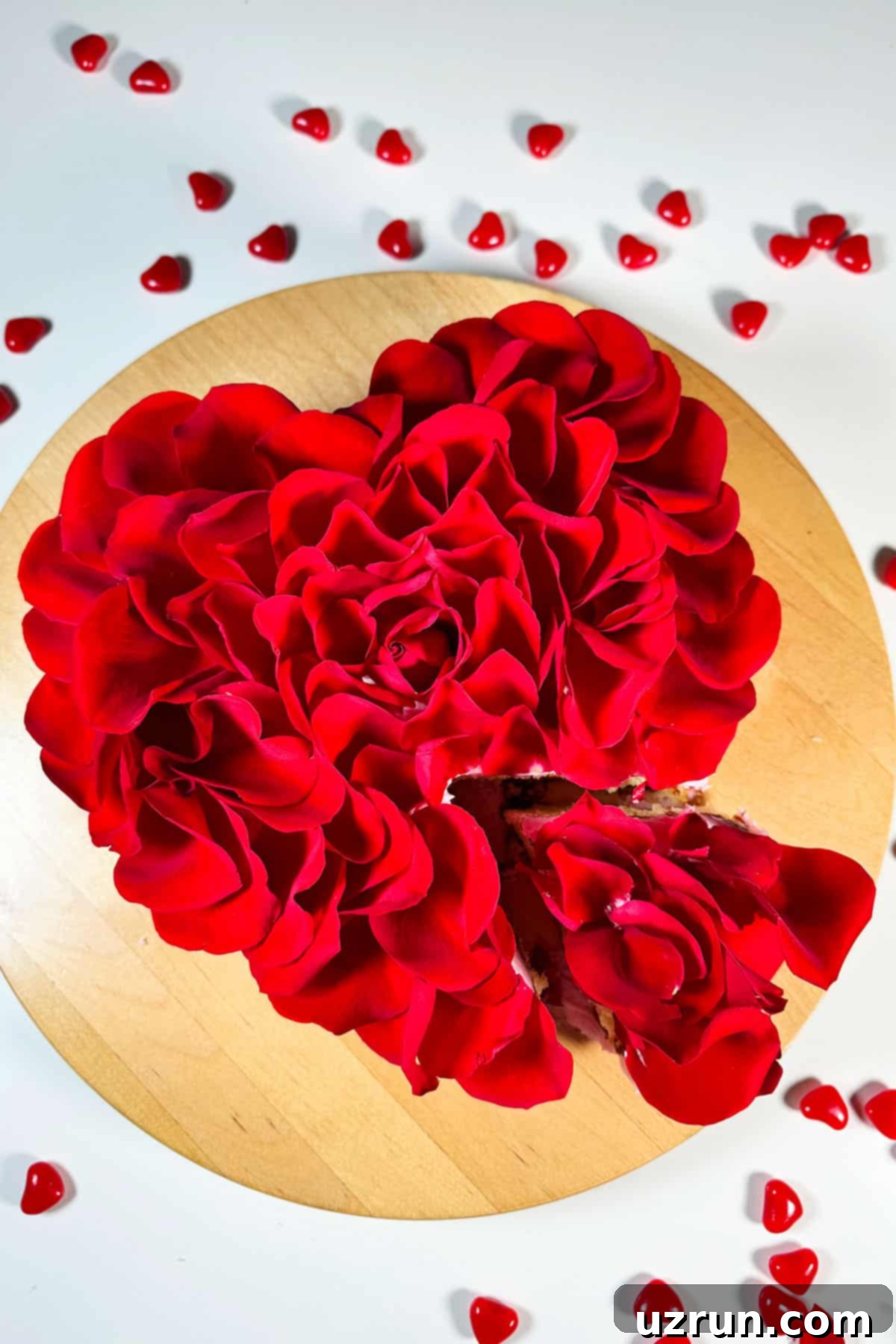The Ultimate Guide to Baking a Stunning Red Rose Cake: Homemade with Rose Water Buttercream & Fresh Petals
Discover how to create the most enchanting and effortlessly elegant red rose cake, a homemade masterpiece that promises to impress. This delightful dessert features a tender cake infused with the delicate essence of rose water and warm vanilla extract, perfectly complemented by a silky rose buttercream frosting. The true showstopper is its exquisite decoration, meticulously adorned with fresh, vibrant rose petals, transforming it into a feast for both the eyes and the palate. Whether you’re celebrating a special occasion or simply indulging in a moment of pure bliss, this recipe guides you through every step to achieve a truly memorable cake experience.
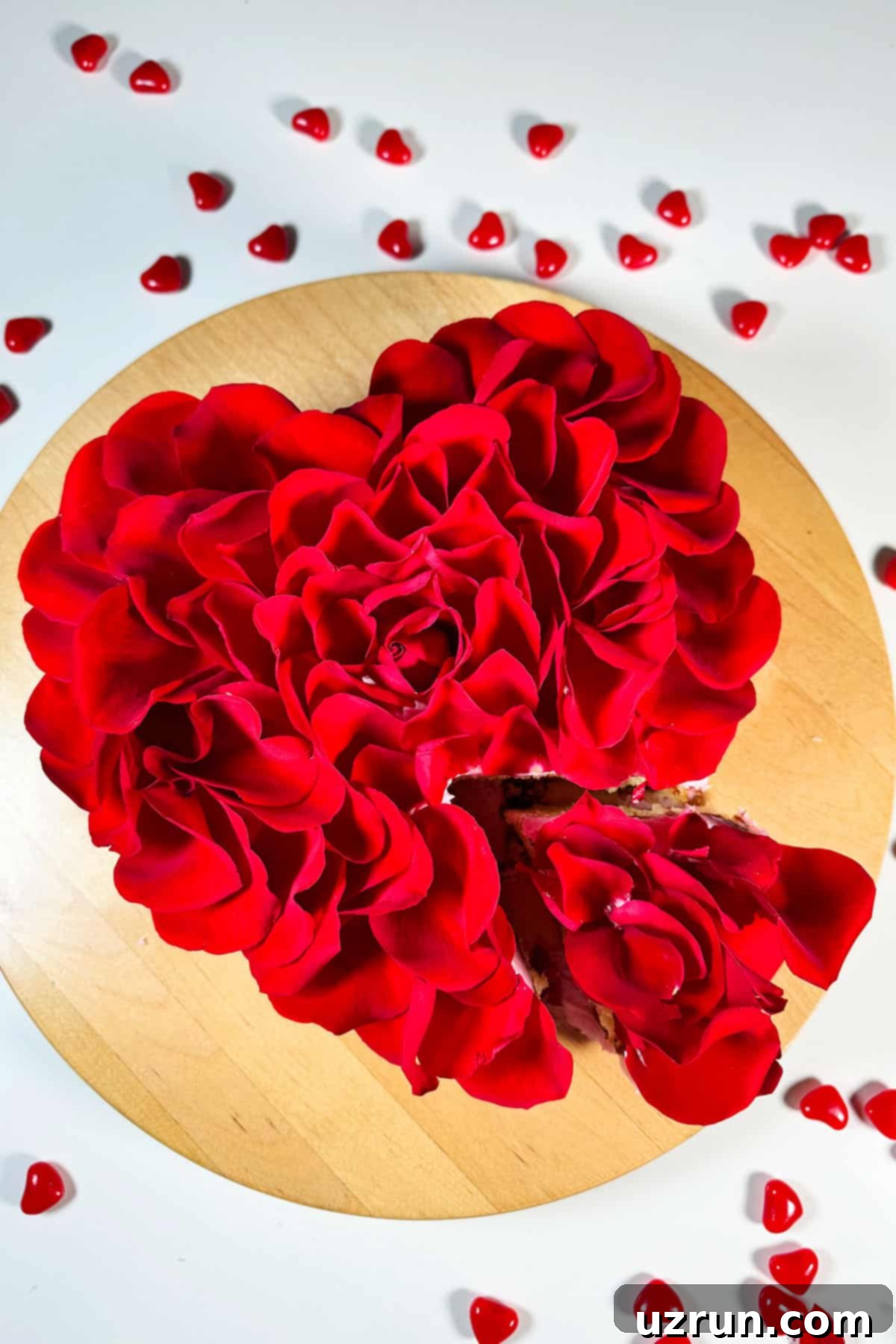
The inspiration for this *red rose cake* struck me quite unexpectedly one morning. I envisioned a cake completely enveloped in the delicate beauty of fresh rose petals, a concept that felt both ambitious and captivating. While the initial idea was a classic round cake, as I began sketching and refining the design, the heart shape naturally emerged as the perfect canvas. It instantly amplified the romantic allure, making this cake the quintessential choice for celebrating love and special moments. Imagine presenting this stunning dessert for Valentine’s Day, gracing the table at a wedding or anniversary celebration, or adding an elegant touch to a birthday party. It’s a design that speaks volumes without a single word. If you’re captivated by the charm of roses, be sure to explore my other floral-inspired creations, including the delightful Rosette Cake, charming Red Rose Cupcakes, and the sweet Easy Rose Cookies. For those who love to craft their decorations, my tutorial on making Easy Fondant Roses (Ribbon Roses) offers another creative way to incorporate roses into your baking repertoire. Get ready to embark on a truly enjoyable baking journey!
Key Ingredients for Your Perfect Red Rose Cake
Crafting this exquisite red rose cake requires a selection of fresh, high-quality ingredients. Each component plays a vital role in achieving the desired flavor, texture, and visual appeal. Here’s a detailed look at what you’ll need to create this romantic dessert:
- Butter: Opt for unsalted butter at room temperature. This ensures it creams smoothly with sugar, incorporating air for a light and fluffy cake crumb and a stable, creamy frosting.
- Granulated Sugar: A foundational ingredient that sweetens the cake and contributes to its moist texture and delicate crust.
- Eggs: Large, room-temperature eggs are essential for proper emulsification, binding the ingredients, and adding richness and structure to the cake batter.
- Milk: Using at least 2% or whole milk at room temperature adds moisture and richness, resulting in a tender and flavorful cake.
- Rose Water: This is the star flavor component, imparting that distinctive, delicate floral aroma and taste that defines a rose cake. Adjust to your preference for a subtle or more pronounced rose essence.
- Vanilla Extract: A classic enhancer, vanilla extract balances and complements the rose water, adding warmth and depth to the overall flavor profile of both the cake and the frosting.
- Cake Flour: Critical for a soft and tender cake. Its lower protein content produces less gluten, resulting in a more delicate crumb.
- All-Purpose Flour: Used in conjunction with cake flour to provide just enough structure without making the cake tough. Do not substitute one for the other entirely in this specific recipe.
- Baking Powder: The primary leavening agent, ensuring your cake rises beautifully and achieves that desirable airy texture.
- Shortening: Incorporated into the buttercream, shortening helps to stabilize the icing, making it incredibly smooth, less prone to melting, and easier to pipe or spread.
- Powdered Sugar: The essential ingredient for creating a smooth, lump-free, and perfectly sweet buttercream frosting. Sifting it prevents a grainy texture.
- Pink Gel Food Coloring: (Optional) A wonderful addition to achieve a subtle, romantic pink hue in your buttercream, enhancing the visual theme of the rose cake. Gel colors are preferred for their vibrancy and minimal liquid content.
- Fresh Roses: The crowning glory for decoration. Ensure you source food-safe roses that have not been treated with pesticides or harmful chemicals. These petals are purely for visual appeal.
Creative Variations to Personalize Your Rose Cake
While the classic red rose cake is a showstopper, don’t hesitate to get creative with these delightful variations to truly make it your own. These ideas can help you customize flavors, textures, and aesthetics for any occasion.
- Pipe Your Own Roses: Instead of using fresh rose petals, you can create an equally stunning effect by piping buttercream roses directly onto the cake. Use a large star tip, such as a 1M, to pipe beautiful rosettes across the entire surface. This is a fantastic option if fresh, food-safe roses are hard to find or if you prefer an edible decoration.
- Infuse with Cardamom and Orange Zest: For a unique twist, consider adding a touch of ground cardamom powder and fresh orange zest to both the cake batter and the frosting. This combination pairs exceptionally well with rose, lending a fragrant, almost Persian-inspired flavor profile that is truly captivating.
- Add Textural Garnishes: Sprinkle some finely chopped pistachios over the top of the cake for a lovely pop of green color and a delightful crunch. Alternatively, use delicate white chocolate shavings to add a touch of contrasting white elegance and a sweet, creamy texture.
- Create a Layered Masterpiece: While this recipe can make a single elegant cake, it yields enough batter for two cake layers. Easily transform it into a stunning layer cake by stacking the two cakes with a delicious filling in the center. Consider fillings like light Whipped Cream, rich Chocolate Whipped Cream, sweet Strawberry Jam, decadent Chocolate Ganache, silky Caramel Sauce, or even a classic Homemade Vanilla Custard. For an even grander presentation, you could create a tiered cake using different sizes of heart-shaped pans, remembering to double or triple the recipe as needed.
- Experiment with Rose Colors: Don’t limit yourself to red! You can achieve a softer, equally beautiful aesthetic by using pink, white, or yellow rose petals for decoration. This also applies if you’re piping buttercream roses – simply tint your frosting to match your desired color palette.
- Explore Other Flavor Combinations: While vanilla and rose are a match made in heaven, feel free to experiment with other extracts. Maple extract can add a cozy sweetness, almond extract can provide a sophisticated nutty undertone, or lemon extract can offer a bright, zesty contrast to the floral notes.
- Create an Ombré Effect: For a truly striking visual, design an ombré cake by arranging rose petals in a gradient. Start with dark red petals at the outer edges, transitioning to lighter pinks and finally to white petals towards the center of the cake. This creates a mesmerizing and artistic display.
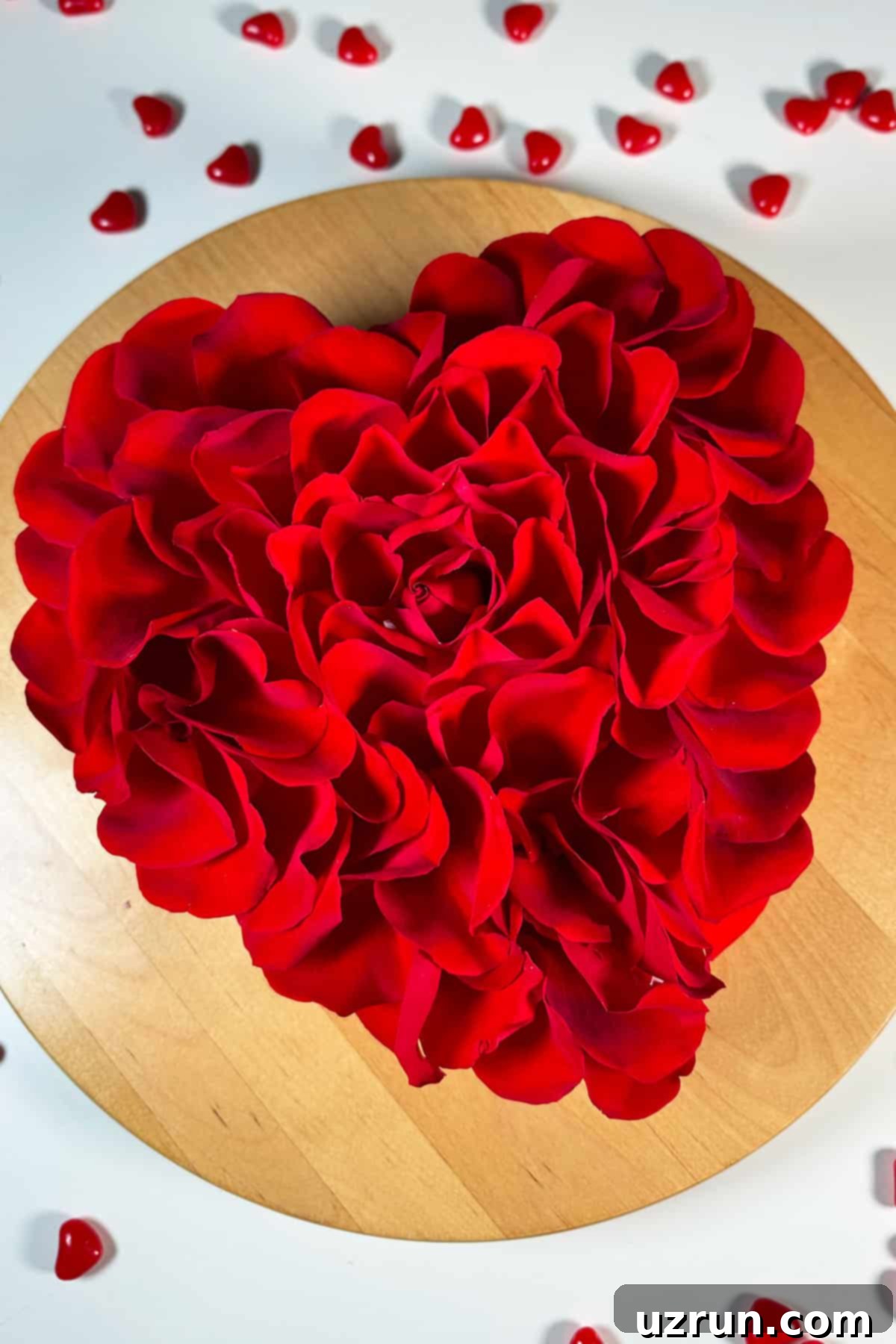
How to Make This Easy Red Rose Cake Recipe from Scratch
Baking this beautiful red rose cake is a surprisingly straightforward process, divided into two main stages: preparing the cake and frosting, then assembling and decorating. Follow these simple steps for a truly delightful result.
Make the Cake and Frosting
- Cream together butter and sugar: In a large mixing bowl, beat the softened unsalted butter with the granulated sugar until the mixture becomes pale, light, and wonderfully fluffy. This step is crucial for incorporating air, which contributes to the cake’s tender texture.
- Mix in wet ingredients: Gradually add the room-temperature eggs, milk, aromatic rose water, and warm vanilla extract to the creamed butter and sugar mixture. Continue mixing until all the wet ingredients are thoroughly combined and the batter is smooth. (See Image 1)
- Sift dry ingredients: In a separate, medium-sized bowl, sift together the cake flour, all-purpose flour, and baking powder. Sifting helps to remove lumps and evenly distribute the leavening agent.
- Combine mixtures: Gently add this sifted dry mixture into the wet ingredients. Mix just until combined, being careful not to over-mix, as this can lead to a tough cake. The batter should be smooth but not overworked. (See Image 2, 3)
- Pour and bake: Divide the prepared batter evenly into two greased and floured heart-shaped cake pans (8-inch pans are ideal). Bake in a preheated oven at 350°F (175°C) for approximately 30-35 minutes, or until a toothpick inserted into the center of the cake comes out clean. Keep a close eye on the cakes starting around the 30-minute mark to prevent over-baking, which can dry them out. (See Image 4)
- Cool cakes: Once baked, remove the cakes from the oven and allow them to cool in their pans on a wire rack for about 10-15 minutes before inverting them onto the rack to cool completely. They must be entirely cool before frosting.
- Prepare the frosting: While the cakes are baking and cooling, prepare the luxurious rose buttercream frosting. In a large mixing bowl, beat the softened butter and shortening together until light and creamy. Gradually add the powdered sugar, about ½ cup at a time, mixing well after each addition. Finally, incorporate the rose water and milk (1 tablespoon at a time) until you achieve a thick, smooth, and spreadable consistency. If desired, add a few drops of pink gel food coloring to achieve a beautiful rosy hue.
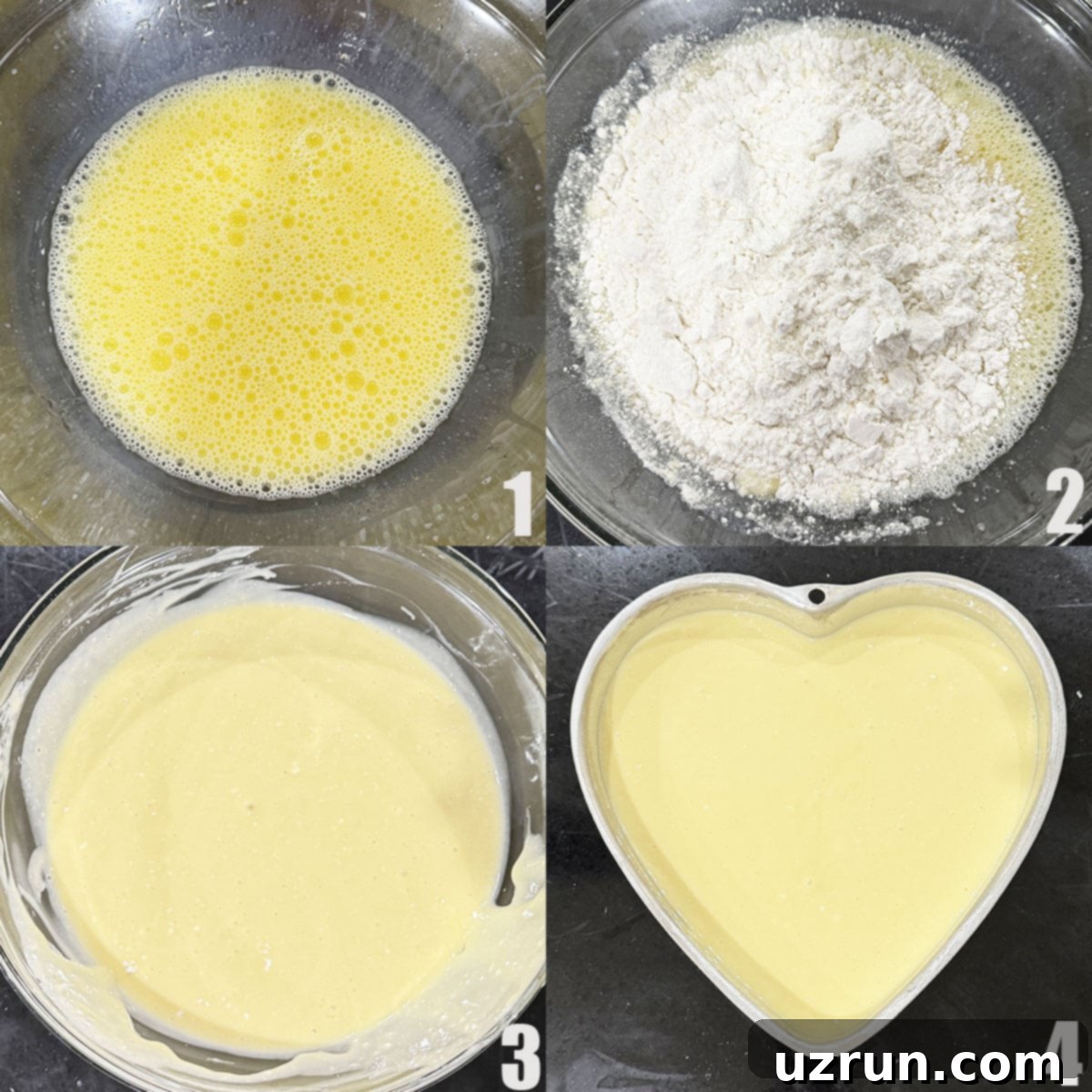
Assemble and Decorate Your Red Rose Cake
Once your cake layers are completely cool and your buttercream is ready, it’s time for the artistic part: assembly and decoration. This is where your vision truly comes to life!
- Prepare cake for frosting: Place one cooled cake layer on your chosen cake dish or stand. If your cake has a slight dome on top, carefully slice it off using a sharp serrated knife to create a flat, even surface for easy frosting. (Note: This recipe yields two cakes. You can use one for a single layer cake and freeze the other, or use both to create a beautiful layer cake.)
- Crumb coat and ice: Apply a thin layer of rose buttercream all over the cake – sides and top. This is called a crumb coat, and it helps to trap any loose crumbs, creating a smooth canvas for your final layer of frosting. Once the crumb coat is set (you can refrigerate it for 15-20 minutes), apply a generous, smooth layer of the remaining rose icing over the entire cake using an offset spatula. Ensure an even and clean finish. (See Image 5)
- Decorate with fresh rose petals: Now for the captivating finale! Gently begin placing the clean, dry fresh rose petals on top of the iced cake. Start from the outer edges, carefully following the heart shape, and work your way inwards. The buttercream acts as a natural adhesive, holding the petals securely in place. Continue arranging the petals in overlapping rows until the entire top surface of the cake is richly covered, creating a dense, luxurious blanket of roses. (See Image 6, 7, 8)
- Serve and enjoy: Once decorated, your magnificent red rose cake is ready to be admired and enjoyed. Remember to remove the petals before serving, as they are for decoration only and can taste bitter.
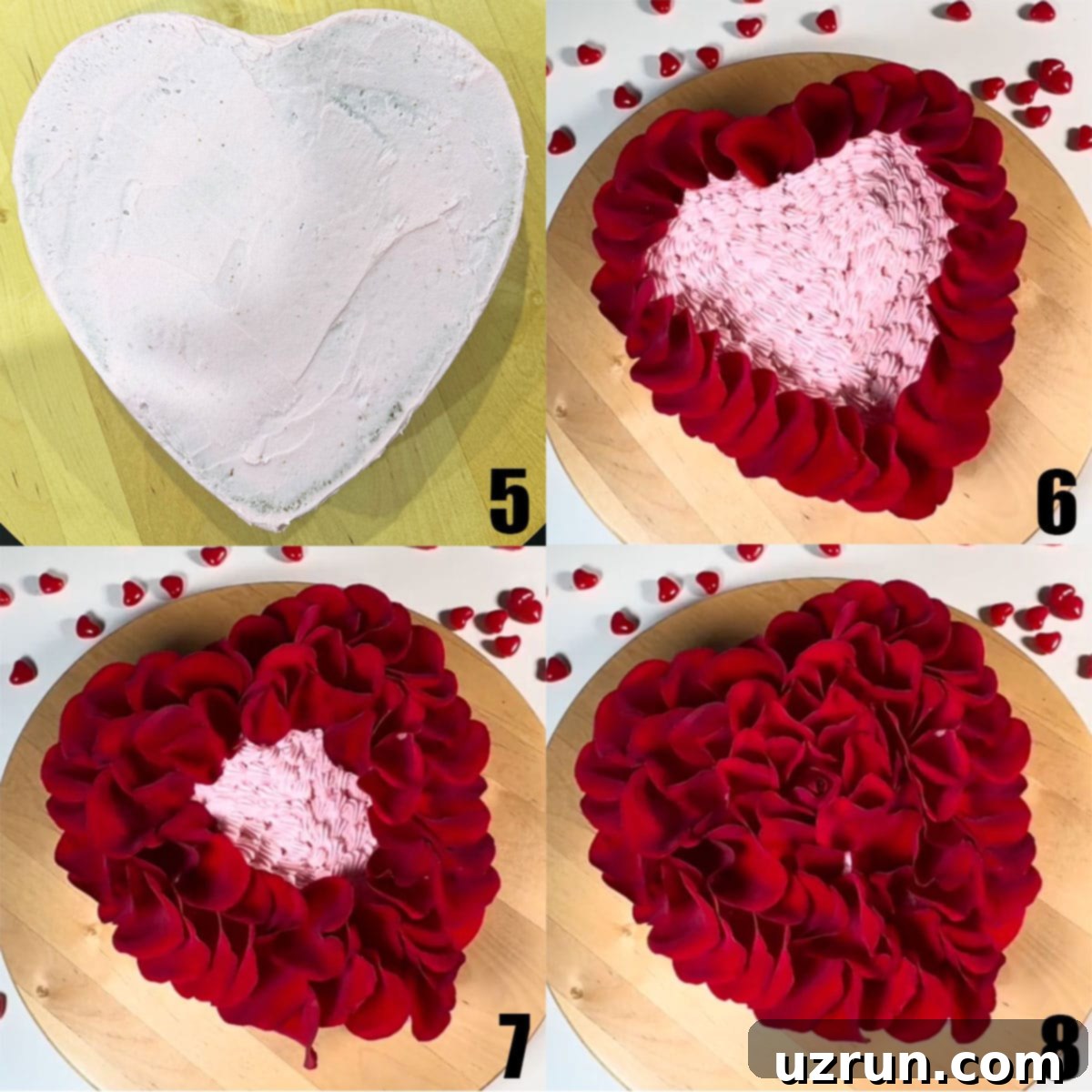
Expert Tips and Techniques for a Flawless Rose Cake
Achieving a bakery-quality red rose cake is within reach with these essential tips and techniques. Pay attention to these details, and your cake will turn out perfectly every time.
- Always use room temperature ingredients: This applies to butter, eggs, and milk. Ingredients that are at room temperature emulsify better, creating a smooth, cohesive batter and a uniform cake texture. Pull them out of the fridge at least 30-60 minutes before you start baking.
- Understand rose flavorings: Rose powder and rose water are not interchangeable. Rose water provides a delicate liquid essence, while rose powder is more concentrated. If using rose powder, you will need to significantly adjust the quantities to avoid an overpowering flavor. Stick to rose water for this recipe.
- The importance of cake flour: Cake flour is key to this recipe’s incredibly soft and tender crumb. It has a lower protein content than all-purpose flour, which results in less gluten development and a more delicate cake. Do not omit or fully substitute it.
- Homemade cake flour hack: If you don’t have store-bought cake flour, you can easily make your own! For every cup of all-purpose flour, remove two tablespoons and replace them with two tablespoons of cornstarch. Sift them together thoroughly before use.
- Adjust rose water to your palate: The amount of rose water specified in the recipe provides a balanced floral note. However, personal preference varies. Feel free to adjust the quantity in both the cake batter and the icing, adding a little less or more until you reach your desired intensity.
- Petals are for decoration only: While fresh rose petals create a stunning visual, they taste very bitter. Always remind guests to remove the petals before eating the cake.
- Ensure food-safe roses: It is paramount to use roses that are specifically grown for culinary use or are certified organic and free from pesticides and harmful chemicals. Always speak to your florist or source them from a reliable, food-grade supplier.
- Thoroughly dry rose petals: After washing your rose petals to remove any dust or debris, gently pat them completely dry with paper towels. Any excess moisture can cause the buttercream to weep or affect the appearance of your decoration.
- Avoid over-mixing the batter: Once you combine the wet and dry ingredients, mix just until no streaks of flour remain. Over-mixing develops too much gluten, which can result in a dense, tough, and chewy cake rather than a light and tender one.
- Prevent over-baking: Begin checking your cakes for doneness at the 30-minute mark. Over-baking is the quickest way to dry out a cake, making it crumbly and less enjoyable. A toothpick inserted into the center should come out clean.
- Optimize cake yield: This recipe makes two 8-inch heart-shaped cakes. You can use one for immediate decoration as a single-layer cake and freeze the other for a future treat. Alternatively, use both layers to create a taller, more impressive tiered cake.
- Layering rose petals for impact: When applying the fresh rose petals, start from the outer edges of the cake and work your way inward, overlapping each petal slightly. This technique creates a full, lush, and natural-looking floral arrangement that completely covers the top surface.
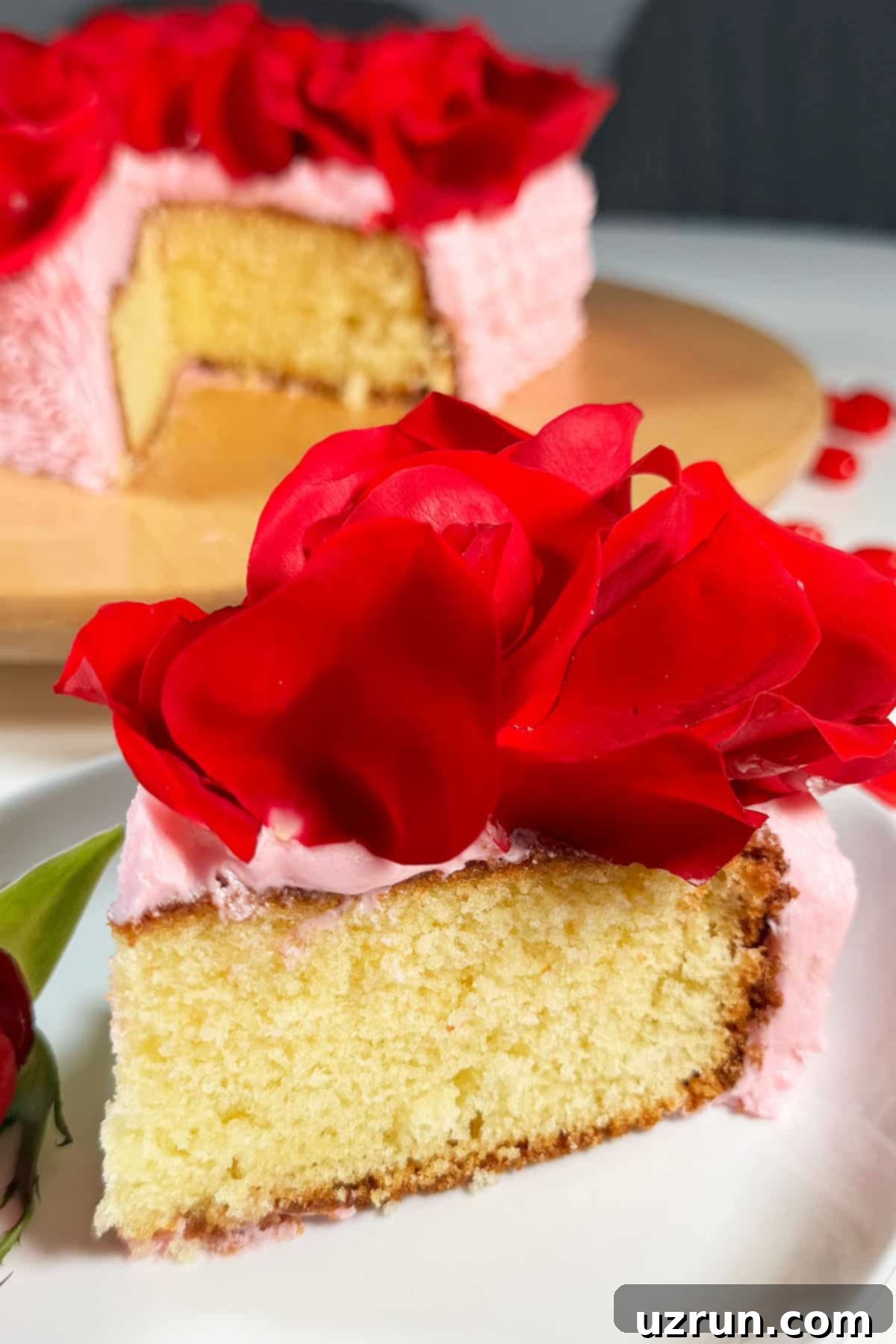
Storage Instructions for Your Rose Cake
Proper storage is key to maintaining the freshness and beauty of your red rose cake. Here’s how to ensure your masterpiece stays delicious for as long as possible:
- Make Ahead: You can prepare and decorate this cake up to 2 days in advance, storing it in the refrigerator. For maximum freshness, consider baking the cake layers and making the frosting separately, storing them in airtight containers for up to 2 days before assembly. Even the fresh roses can be stored in the fridge for a few days (unwashed) until you’re ready to decorate.
- Room Temperature: It’s generally not recommended to leave this decorated cake out at room temperature for extended periods. Fresh rose petals can wilt quickly, and the buttercream frosting may soften or melt, especially in warm or humid conditions. If serving at a party, bring it out just before guests arrive.
- Refrigerate Leftovers: Any leftover cake should be stored in a sealed, airtight container in the refrigerator for up to 3 days. Be aware that the fresh rose petals will likely lose their vibrant shape and texture once refrigerated, so it’s best to remove them from slices before storing.
- Freezing Un-decorated Cake: An undecorated cake layer freezes beautifully! Wrap it tightly in plastic wrap, then aluminum foil, and place it in an airtight container or freezer-safe bag. It can be stored in the freezer for up to 1 month. When ready to use, thaw the cake overnight in the refrigerator before proceeding with frosting and decoration as per the instructions.
Recipe FAQs for Your Red Rose Cake
Have questions about baking this romantic red rose cake? Here are answers to some of the most common queries.
Safety is paramount when decorating with fresh flowers. First, ensure your roses are food-safe and have not been treated with any harmful chemicals or pesticides. Always wash them thoroughly under cool running water, then gently pat them completely dry with paper towels before placing them on the cake. Remember, these petals are for decorative purposes only; they should be removed before serving and eating the cake, as they can be bitter.
For the cake batter, this recipe calls for 2 teaspoons of rose water to infuse a delicate floral essence. For the frosting, you’ll need 1 to 2 teaspoons, depending on your personal preference for the intensity of the rose flavor. It’s always best to start with a smaller amount and add more gradually, tasting as you go, to avoid an overpowering taste.
This dessert earns its name, “rose cake,” from its delightful double dose of rose goodness! It incorporates the delicate and aromatic flavor of rose water (and sometimes rose powder) directly into both the cake batter and the buttercream frosting. To complete the theme and create a truly breathtaking visual, it is elegantly decorated with real, fresh rose petals on top.
More Flower-Inspired Desserts to Bloom Your Kitchen
If you loved creating this rose-themed cake, you might enjoy exploring other beautiful flower desserts that are just as delightful to make and share:
- Easy Flower Cookies
- Flower Basket Cake (Basketweave)
- Fondant Flower Cake
- Easy Flower Cupcakes (Fondant Pansy)
Full Recipe: Easy Red Rose Cake (With Rose Water)
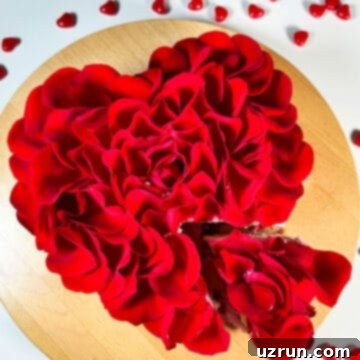
Easy Red Rose Cake (With Rose Water)
Abeer Rizvi
Pin Recipe
10 minutes
30 minutes
10 minutes
50 minutes
Dessert
American
9 Slices
921 kcal
Want to Save This Recipe?
Enter your email & I’ll send it to your inbox. Plus, get great new recipes from me every week!
By submitting this form, you consent to receive emails from CakeWhiz
Equipment
-
Kitchenaid mixer (or stand mixer with paddle attachment)
-
Measuring cups
-
Measuring spoons
-
Sharp serrated knife
-
Offset spatula (for frosting)
-
Large and medium mixing bowls
-
Two 8-inch heart cake pans (or round pans)
-
Wire cooling rack
Ingredients
For the Rose Water Cake
- ½ cup Butter (Unsalted, at Room Temperature)
- 1 cup Granulated sugar
- 2 Large Eggs (at Room Temperature)
- ½ cup Milk (Whole or 2%, at Room Temperature)
- 2 teaspoons Rose water
- ½ teaspoon Vanilla extract
- 1 cup Cake flour
- ¾ cups All-purpose flour
- 1.5 teaspoons Baking powder
For the Rose Buttercream Frosting
- 1.5 cups Butter (Unsalted, at Room Temperature)
- ½ cup Shortening
- 2 teaspoons Rose water (Start with 1 teaspoon if you prefer a milder flavor, adjust to taste)
- 5 cups Powdered sugar
- 2-4 tablespoons Milk (Whole or 2%, or use heavy cream for a richer texture)
- Pink gel food coloring (Optional, for a vibrant rosy hue)
For Decoration
- 6 Fresh roses (Crucially, ensure these are food-safe and have not been sprayed with pesticides or other chemicals. Carefully remove all petals, rinse them gently with water, and thoroughly pat them dry on paper towels before use.)
Instructions
-
In a large mixing bowl, using an electric mixer, cream together the softened butter and granulated sugar until the mixture is light, fluffy, and significantly paler in color. This process usually takes 3-5 minutes and is essential for a tender cake.
-
Add the room-temperature eggs one at a time, mixing well after each addition. Then, stir in the milk, rose water, and vanilla extract. Mix until just smooth and fully incorporated.
-
In a separate, medium-sized bowl, sift together the cake flour, all-purpose flour, and baking powder. Sifting prevents lumps and ensures even distribution of the leavening agent.
-
Gradually add this sifted dry mixture into the wet ingredients in the large mixing bowl. Mix on low speed just until the ingredients are combined and no streaks of dry flour are visible. Be very careful not to over-mix, as this can lead to a dense, tough cake.
-
Divide the cake batter evenly between two 8-inch heart-shaped cake pans that have been thoroughly greased and floured. Ensure the pans are prepared properly to prevent sticking.
-
Bake in a preheated oven at 350°F (175°C) for approximately 30-35 minutes. To check for doneness, insert a toothpick into the center of the cake; it should come out clean. Begin checking the cakes around the 30-minute mark to avoid over-baking, which can dry out the cake.
-
Once baked, remove the cakes from the oven and let them cool in their pans on a wire rack for 10-15 minutes. Then, invert them onto the wire rack to cool completely to room temperature before frosting. Warm cakes will melt your frosting.
-
While the cakes are baking and cooling, you can efficiently prepare the luxurious rose buttercream frosting.
-
In a large mixing bowl, combine the softened unsalted butter, rose water, and shortening. Beat with an electric mixer until thoroughly combined and creamy.
-
Gradually add the powdered sugar, approximately ½ cup at a time, to the butter mixture while continuing to mix on low speed. Ensure each addition is well incorporated before adding more to prevent a sugary cloud.
-
Once all the powdered sugar is incorporated, add the milk (1 tablespoon at a time) while continuing to mix. Beat until you achieve a thick, smooth, and wonderfully creamy consistency that is easy to spread. If desired, add a few drops of pink gel food coloring to tint the frosting.
-
To assemble your cake, place one cooled cake layer on a large cake dish or stand. (Note: This recipe yields two cakes. For this single-layer design, I used one cake and froze the other for later enjoyment. Feel free to use both layers to create a gorgeous stacked cake, adding a filling if you wish.)
-
If the cake layer has a slight dome, carefully slice it off using a sharp serrated knife to create a flat and even surface for easy frosting application.
-
Using an offset spatula, generously ice the entire cake (top and sides) smoothly with the prepared rose buttercream. Strive for an even and clean finish as this will be the base for your petal decoration.
-
Begin placing the clean and dry fresh rose petals on top of the cake. Start from the outer edges, following the natural curve of your heart-shaped cake, and work your way inwards. The creamy icing will act as a “glue,” holding the petals in place. Continue arranging the petals in slightly overlapping rows until the entire top surface of the cake is beautifully covered. Your stunning red rose cake is now ready to be admired and enjoyed!
Video Guide
Chef’s Notes
- Always adjust the quantity of rose water in both the cake batter and the icing to your personal preference for floral intensity.
- Remember to remove the fresh rose petals just before serving the cake, as they are for visual beauty and taste quite bitter.
- Feel free to experiment with other complementary extracts and flavors. Vanilla and rose are a classic pairing, but almond, maple, or even a hint of lemon can also be delightful.
- Get creative with your floral palette! Use other colors of food-safe roses, such as soft pink, elegant white, or sunny yellow petals, to match your occasion or theme.
- Crucially, ensure that any roses used for decoration are food-safe and have not been sprayed with pesticides or other chemicals. Always communicate this with your florist when purchasing.
- After washing your rose petals, it’s vital to pat them completely dry with paper towels. Any moisture can cause the buttercream to break down or the petals to droop.
- For more in-depth advice and creative ideas, make sure to read the “Tips and Techniques” and “Variations” sections above.
- Leftover cake can be stored in a sealed container in the fridge for up to 3 days, but be aware that the fresh petals will unfortunately lose their crisp shape and vibrancy.
Nutrition Information
Carbohydrates: 108g
Protein: 5g
Fat: 54g
Saturated Fat: 29g
Polyunsaturated Fat: 5g
Monounsaturated Fat: 16g
Trans Fat: 3g
Cholesterol: 147mg
Sodium: 348mg
Potassium: 145mg
Fiber: 1g
Sugar: 88g
Vitamin A: 1341IU
Calcium: 72mg
Iron: 1mg
An automated tool is used to calculate the nutritional information. As such, I cannot guarantee the accuracy of the nutritional information provided for any recipe on this site.
Tried this recipe?
Leave a comment below or rate and tag @cakewhiz on social
